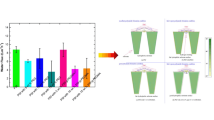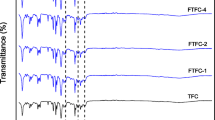Abstract
Thin film composite (TFC) technology has been widely used to prepare reverse osmosis (RO) membrane, in which the relationship between support layer and selective layer plays a significant role. To thoroughly clarify the influence of support layer pore size on the properties of selective layer, herein, we prepared a series of polysulfone (PSf) support layers with different surface pore sizes by adjusting casting solution concentrations. Afterward, polyamide (PA) selective layers were prepared on top of PSf support layers via interfacial polymerization method. Detailed studies were performed to illustrate membrane-forming dynamics, TFC morphologies and membrane performances. The pore size of support layer has a substantial effect on the aqueous monomer diffusion behavior as well as selective layer morphologies and overall performances; specifically, resulting in differences in both thickness and roughness of PA layer and also inducing different membrane performances. Combined with anti-backflush experiments, we also provide an insight view into the interfacial adhesion between support layer and selective layer.













Similar content being viewed by others
References
Werber JR, Osuji CO, Elimelech M (2016) Materials for next-generation desalination and water purification membranes. Nat Rev Mater 1(5):1–15
Liang CZ et al (2021) Ultra-strong polymeric hollow fiber membranes for saline dewatering and desalination. Nat Commun 12(1):1–12
Liu LF et al (2006) Study on a novel polyamide-urea reverse osmosis composite membrane (ICIC–MPD): I. Preparation and characterization of ICIC–MPD membrane. J Membr Sci 281(1–2):88–94
Li L et al (2008) Polyamide thin film composite membranes prepared from isomeric biphenyl tetraacyl chloride and m-phenylenediamine. J Membr Sci 315(1–2):20–27
Xu R et al (2020) Preparation and performance of a charge-mosaic nanofiltration membrane with novel salt concentration sensitivity for the separation of salts and dyes. J Membr Sci 595:117472
Kim SH, Kwak S-Y, Suzuki T (2005) Positron annihilation spectroscopic evidence to demonstrate the flux-enhancement mechanism in morphology-controlled thin-film-composite (TFC) membrane. Environ Sci Technol 39(6):1764–1770
Xu R et al (2018) Influence of l-lysine on the permeation and antifouling performance of polyamide thin film composite reverse osmosis membranes. RSC Adv 8(44):25236–25247
Zhang H-L, Gao Y-B, Gai J-G (2018) Guanidinium-functionalized nanofiltration membranes integrating anti-fouling and antimicrobial effects. J Mater Chem A 6(15):6442–6454
Zhao Q, Zhao DL, Chung TS (2021) Thin-film nanocomposite membranes incorporated with defective ZIF-8 nanoparticles for brackish water and seawater desalination. J Membr Sci 625:119158
Lind ML et al (2010) Tailoring the structure of thin film nanocomposite membranes to achieve seawater RO membrane performance. Environ Sci Technol 44(21):8230–8235
Schlenoff JB (2014) Zwitteration: coating surfaces with zwitterionic functionality to reduce nonspecific adsorption. Langmuir 30(32):9625–9636
Shi Q et al (2011) Grafting short-chain amino acids onto membrane surfaces to resist protein fouling. J Membr Sci 366(1–2):398–404
Kessler D, Roth PJ, Theato P (2009) Reactive surface coatings based on polysilsesquioxanes: controlled functionalization for specific protein immobilization. Langmuir 25(17):10068–10076
Zhang Q et al (2017) Novel insights into the interplay between support and active layer in the thin film composite polyamide membranes. J Membr Sci 537:372–383
Li X et al (2012) Thin-film composite membranes and formation mechanism of thin-film layers on hydrophilic cellulose acetate propionate substrates for forward osmosis processes. Ind Eng Chem Res 51(30):10039–10050
Ghosh AK, Hoek EM (2009) Impacts of support membrane structure and chemistry on polyamide–polysulfone interfacial composite membranes. J Membr Sci 336(1–2):140–148
Askari M et al (2021) Optimization of TFC-PES hollow fiber membranes for reverse osmosis (RO) and osmotically assisted reverse osmosis (OARO) applications. J Membr Sci 625:119156
Wang J et al (2018) Probing influences of support layer on the morphology of polyamide selective layer of thin film composite membrane. J Membr Sci 556:374–383
Singh PS et al (2006) Probing the structural variations of thin film composite RO membranes obtained by coating polyamide over polysulfone membranes of different pore dimensions. J Membr Sci 278(1–2):19–25
Jimenez-Solomon MF et al (2013) Beneath the surface: Influence of supports on thin film composite membranes by interfacial polymerization for organic solvent nanofiltration. J Membr Sci 448:102–113
Hirose M (1997) The relationship between polymer molecular structure of RO membrane skin layers and their RO performances. J Membr Sci 123(2):151–156
Hu Y et al (2017) Molecular mechanism for liquid–liquid extraction: Two-film theory revisited. AIChE J 63(6):2464–2470
Shi Q et al (2017) Poly (p-phenylene terephthamide) embedded in a polysulfone as the substrate for improving compaction resistance and adhesion of a thin film composite polyamide membrane. J Mater Chem A 5(26):13610–13624
Kim HI, Kim SS (2006) Plasma treatment of polypropylene and polysulfone supports for thin film composite reverse osmosis membrane. J Membr Sci 286(1–2):193–201
Park S-J et al (2017) Fabrication of polyamide thin film composite reverse osmosis membranes via support-free interfacial polymerization. J Membr Sci 526:52–59
Lee J et al (2013) Water vapor sorption and free volume in the aromatic polyamide layer of reverse osmosis membranes. J Membr Sci 425:217–226
Wenzel RN (1949) Surface roughness and contact angle. J Phys Chem 53(9):1466–1467
Wang J et al (2021) Conditional uncorrelation and efficient subset selection in sparse regression. IEEE Transactions on Cybernetics
Wang J et al (2018) Multivariate correlation entropy and law discovery in large data sets. IEEE Intell Syst 33(5):47–54
Liu T et al (2021) Construction of a composite microporous polyethylene membrane with enhanced fouling resistance for water treatment. J Membr Sci 618:118679
Wang D, Schwartz DK (2020) Non-Brownian Interfacial Diffusion: Flying, Hopping, and Crawling. The Journal of Physical Chemistry C 124(37):19880–19891
Ghosh AK et al (2008) Impacts of reaction and curing conditions on polyamide composite reverse osmosis membrane properties. J Membr Sci 311(1–2):34–45
Duan M et al (2010) Influence of hexamethyl phosphoramide on polyamide composite reverse osmosis membrane performance. Sep Purif Technol 75(2):145–155
Acknowledgements
The authors gratefully appreciate the financial support from the National Natural Science Foundation of China (NSFC 51503134, 51721091) and the State Key Laboratory of Polymer Materials Engineering (SKLPME 2017-3-02). We also would like to thank Meng Deng from Shiyanjia Lab (www.shiyanjia.com) for the SEM test.
Author information
Authors and Affiliations
Corresponding authors
Additional information
Publisher's Note
Springer Nature remains neutral with regard to jurisdictional claims in published maps and institutional affiliations.
Rights and permissions
About this article
Cite this article
Gao, F., Chen, D., Liu, T. et al. Influence of support layer pore size on interfacial polymerization and polyamide selective layer characterization. J Polym Res 28, 364 (2021). https://doi.org/10.1007/s10965-021-02736-2
Received:
Accepted:
Published:
DOI: https://doi.org/10.1007/s10965-021-02736-2




